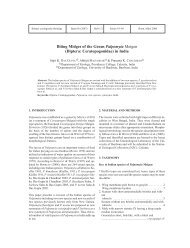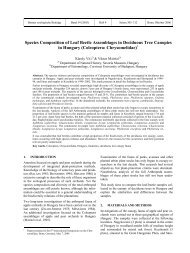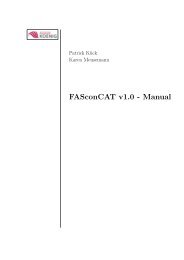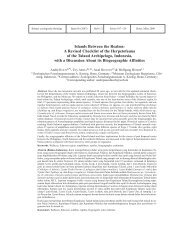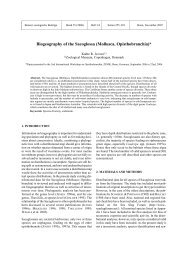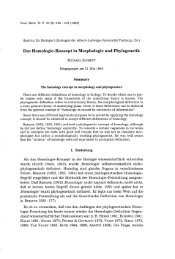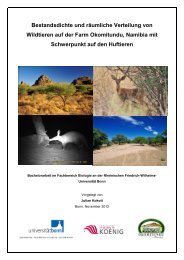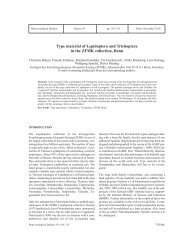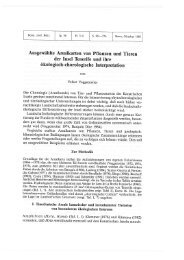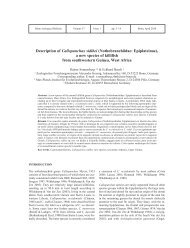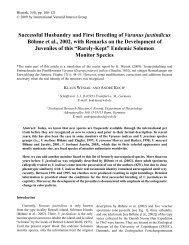cephalic shield
cephalic shield
cephalic shield
You also want an ePaper? Increase the reach of your titles
YUMPU automatically turns print PDFs into web optimized ePapers that Google loves.
316 Sid STAUBACH & Annette KLUSSMANN-KOLB: Cephalic sensory organ in Aceton<br />
1993). HO F F M A N N (1939) described the same nerve as the<br />
Nervus proboscidis. We define this nerve however, as<br />
Nervus clypei capitis according to HUBER (1993).<br />
Considering the homologisation of the cerebral nerves in<br />
light of their neurological origin, neuro-anatomics and<br />
nervous innervation patterns, we postulate hypotheses of<br />
homologies respective of the organs innervated by these<br />
nerves. Thus, we consider the lip of A. tornatilis to be homologous<br />
to the lip of Cephalaspideans (HUBER 1993)<br />
since both organs are innervated by the N1. The same<br />
holds true for the small median parts of the <strong>cephalic</strong> <strong>shield</strong><br />
in Acteon and the anterior <strong>cephalic</strong> <strong>shield</strong> of Haminoea.<br />
We could not find a lip organ in A. tornatilis as described<br />
by EDLINGER (1980), but we detected a groove at the ventral<br />
side of the anterior <strong>cephalic</strong> <strong>shield</strong>. This groove is innervated<br />
by the N2 as is the lip organ of Cephalaspideans<br />
(HUBER 1993). Therefore, we postulate this groove to be<br />
homologous to the lip organ. This hypothesis is also supported<br />
by data on immunoreactivity against several neurotransmitters.<br />
In the groove of A. tornatilis as well as in<br />
the lip organ of H. hydatis, characteristic sub-epidermal<br />
sensory neurons containing catecholamines could be found<br />
in high density indicating that both organs are involved<br />
in contact chemoreception (S. FALLER, Frankfurt, pers.<br />
comm. 2007).<br />
The N2 of Haminoea is divided into two branches which<br />
are described as two single nerves by EDLINGER (1980).<br />
The first or inner branch provides the lip organ as described<br />
earlier. The second, outer branch is related to the<br />
anterior Hancock´s organ ( ED L I N G E R 1980; HU B E R 1 9 9 3 ).<br />
In Acteon we also found two branches of the N2: the inner<br />
one providing the largest part of the groove whereas<br />
the outer branch is restricted to a small region between<br />
the anterior and posterior lobe of the <strong>cephalic</strong> <strong>shield</strong>.<br />
Therefore, this latter region may be homologous to the anterior<br />
Hancock´s organ of H. hydatis and not to the posterior<br />
Hancock´s organ as described by EDLINGER (1980).<br />
The N3 of A. tornatilis provides a large part of the posterior<br />
<strong>cephalic</strong> <strong>shield</strong> but no identifiable posterior Hancock´s<br />
organ. Additional immunohistochemical and ultrastructural<br />
investigations could also not detect a posterior<br />
Hancock´s organ in A. tornatilis (S. FALLER, Frankfurt,<br />
pers. comm. 2007; GÖBBELER & KLUSSMANN-KOLB in<br />
p re s s). The posterior parts of the <strong>cephalic</strong> <strong>shield</strong>s in A c t e o n<br />
and Haminoea are probably equally homologous as both<br />
where innervated by the Nclc.<br />
The lack of a posterior Hancock´s organ in A. tornatilis<br />
might be due to three different reasons: 1. the ancestor of<br />
A. tornatilis never had a posterior Hancock´s organ; 2. the<br />
posterior <strong>cephalic</strong> <strong>shield</strong> of A. tornatilis may be a homologous<br />
structure to the posterior Hancock´s organ of H. hy -<br />
datis; and 3. the posterior Hancock´s organ has secondarily<br />
been reduced in A. tornatilis.<br />
The first hypothesis is rather implausible since we found<br />
a distinct N3 with conserved cellular innervation patterns<br />
in the central nervous system. If the ancestor of A. tornatilis<br />
never had a posterior Hancock´s organ, this nerve<br />
and associated neural structures should be lacking. Moreover,<br />
a Hancock´s organ has been described for other<br />
Acteonoidea (RU D M A N 1 9 7 1a, b; RU D M A N 1972a, b; RU D-<br />
MAN 1972c). If we consider the second explanation for<br />
lack of a posterior Hancock´s organ in A. tornatilis, we<br />
imply that the posterior <strong>cephalic</strong> <strong>shield</strong> in this species, innervated<br />
by the N3, presents a sensory organ as the Hancock´s<br />
organ in Cephalaspidea. However, immunohistochemical<br />
and ultrastructural investigations of the respective<br />
epithelia in A. tornatilis do not indicate a sensory function<br />
at all (S. FALLER, Frankfurt, pers. comm. 2007;<br />
GÖBBELER & KLUSSMANN-KOLB in press). We reject this<br />
hypothesis of homology of the posterior <strong>cephalic</strong> <strong>shield</strong><br />
in A. tornatilis and posterior Hancock´s organ in H. hy -<br />
d a t i s since we found no evidence for a function of the posterior<br />
<strong>cephalic</strong> <strong>shield</strong> as an olfactory sensory organ. Moreo<br />
v e r, the posterior <strong>cephalic</strong> <strong>shield</strong> is mostly innervated by<br />
the Nclc and not by the N3. The third hypothesis regarding<br />
the reduction of a Hancock´s organ seems to be the<br />
most plausible when the habitat and the food sources of<br />
A. tornatilis in comparison to H. hydatis are considered.<br />
The posterior Hancock´s organ is believed to be an olfactory<br />
sensory organ (AU D E S I R K 1979; EM E RY 1 9 9 2). H. hy -<br />
datis feeds on green algae which occur in patches in open<br />
water whereas A. tornatilis is a predator of soft invertebrates<br />
living up to ten centimeters in solid sand (FRETTER<br />
1939; YONOW 1989; own investigations). In such an environment,<br />
an olfactory sensory organ is not plausible<br />
since olfaction or distance chemoreception is generally associated<br />
with water currents, which are not substantial in<br />
a sandy substrate habitat. Here, a contact chemoreceptor,<br />
which is located near the edge of the <strong>cephalic</strong> <strong>shield</strong> is<br />
more plausible. This we witnessed in Acteon tornatilis v i a<br />
its display of a potentially chemoreceptive groove along<br />
the lateral margin of the anterior <strong>cephalic</strong> <strong>shield</strong>.<br />
This assumption of secondary reduction of the Hancock´s<br />
o rgan in the endobenthic A. tornatilis is also supported by<br />
the fact that a Hancock´s organ has been described for other<br />
epibenthic Acteonoidea (e. g. Bullina, Micromelo, Hy -<br />
datina) (RUDMAN 1971a, b; RUDMAN 1972a, b; RUDMAN<br />
1972a,b,c).<br />
Despite all discussion, homology of the described Hancock´s<br />
organs to those in Cephalaspidea cannot undoubtedly<br />
be proposed at this stage, particularly since data on<br />
innervation patterns in these acteonids are lacking to date.<br />
M o r e o v e r, current phylogenetic hypotheses (GR A N D E et al.




